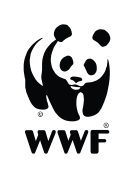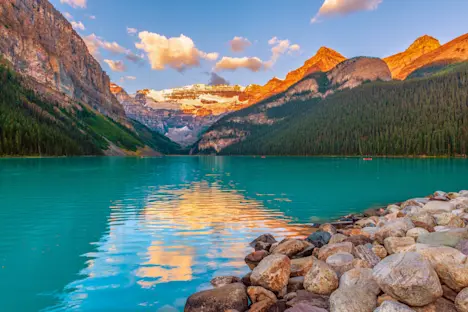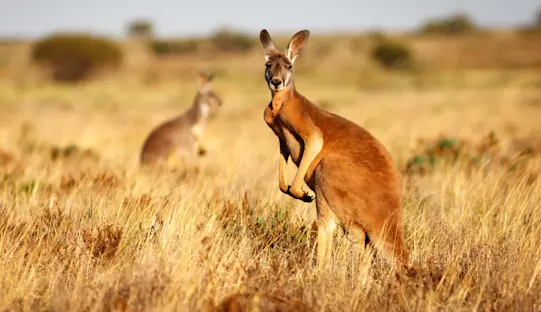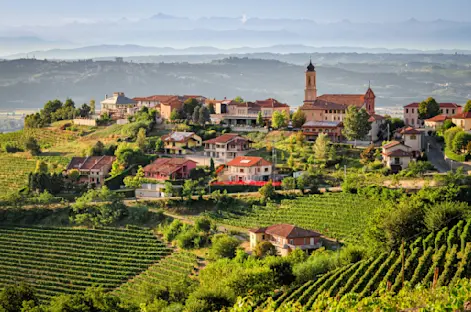
Know Before You Go: Alaska Adventures


Where Should I Go in Alaska?
Alaska is home to some of the wildest and most remote national parks in the U.S.—and they’re also among the best for wildlife viewing. Whether you’re watching brown bears fish for salmon in Katmai or spotting whales near coastal glaciers in Kenai Fjords, each region offers something unique. From renowned parks like Denali to remote and rugged landscapes like Lake Clark, these destinations offer unparalleled access to wild Alaska.
Top Alaska Wildlife Regions
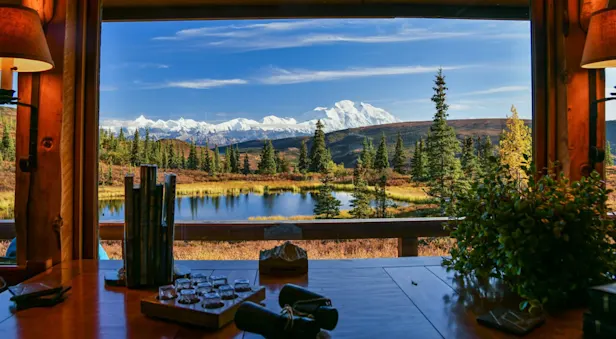
Denali
Key Wildlife
Moose, caribou, Dall sheep, bears, wolves
Scenery Highlights
Tundra, boreal forest, towering peaks
How to Explore
Flightseeing, park road (partial access), guided hikes
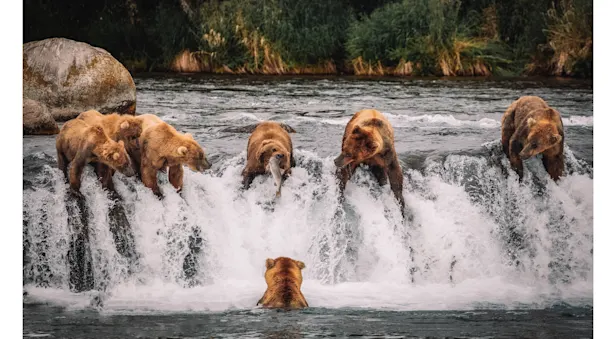
Katmai
Key Wildlife
Brown bears (salmon fishing), river otters, bald eagles
Scenery Highlights
Rivers, waterfalls, volcanic terrain
How to Explore
Bear viewing on foot, photography platforms, boat
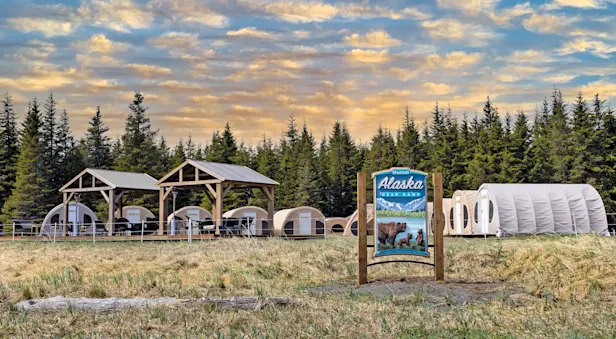
Lake Clark
Key Wildlife
Brown bears, eagles, foxes, marine life
Scenery Highlights
Volcanoes, coastline, solitude
How to Explore
Fly-in lodges, guided hikes, coastal exploration
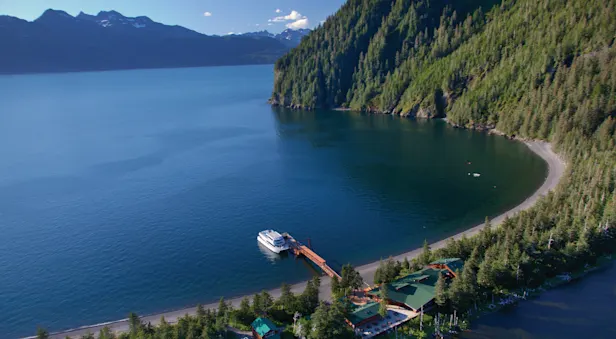
Kenai Fjords
Key Wildlife
Humpbacks, orcas, puffins, Steller sea lions, seals
Scenery Highlights
Glaciers, fjords, coastal rainforest
How to Explore
Day cruises, sea kayaking, coastal hikes
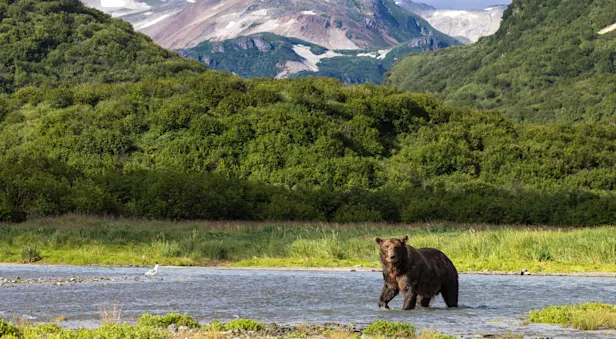
Kodiak Island
Key Wildlife
Brown bears, sea otters, bald eagles, foxes
Scenery Highlights
Coastal mountains, spruce forests, beaches
How to Explore
Boat tours, bear viewing excursions, guided hikes
Denali National Park – Iconic Wildlife and Peaks
Denali is Alaska’s most famous national park, celebrated for its breathtaking wilderness and Denali—North America’s tallest mountain at 20,310 feet. Located in central Alaska, about 240 miles north of Anchorage, Denali National Park and Preserve spans more than 6 million acres of rugged terrain, including tundra valleys, boreal forest, braided rivers and glacier-carved peaks. This vast, protected landscape supports some of the state’s richest wildlife habitat.
In Denali, travelers may spot Alaska’s “Big Five”: moose, caribou, Dall sheep, wolves and grizzly bears. Clear days reveal dramatic views of Denali rising high above the Alaska Range, while the park’s remote backcountry invites exploration on foot or by air.
How to Visit Denali:
Most visitors access the park via the Denali Park Road, a 92-mile route that winds deep into the wilderness. However, private vehicles are only allowed on the first 15 miles—beyond that, transit or narrated tour buses are required, unless you hold a special permit. Hiking is largely trail-less, offering a true wilderness experience for experienced adventurers.
Wildlife sightings are best with expert naturalist guides who understand animal behavior and know where to look. With a small-group tour like Nat Hab’s, guests can explore deeper into the park, away from crowds, for more intimate and ethical wildlife encounters.
Highlights include:
Wildlife safaris and guided hikes with naturalist guides
Backcountry exploration on foot or by scenic flight
Stays at remote wilderness lodges, accessed by helicopter
Denali is also one of the most accessible parks in Alaska, reachable by road or rail from Anchorage and Fairbanks—making it an ideal addition to any Alaska itinerary.
Kenai Fjords – Glaciers and Marine Life
Kenai Fjords National Park is where towering mountains plunge into icy seas, and wildlife thrives at the edge of the continent. Located near Seward on the Kenai Peninsula, this spectacular park is renowned for its tidewater glaciers, deep fjords and rich marine ecosystems. While most of the park is roadless, visitors can access key areas by boat, kayak or on foot from trailheads near Seward.
Much of the park’s coastline is explored via chartered wildlife boat tours through Resurrection Bay and Aialik Bay, where travelers encounter humpback whales breaching, orcas on the hunt, and sea otters floating among icebergs. Puffins, sea lions and bald eagles are also common sights, especially near cliffside rookeries and coastal forests.
Visitors can also explore Exit Glacier, one of the park’s most accessible land-based glaciers. A network of hiking trails just outside Seward offers views of glacial ice, alpine meadows and the Harding Icefield—the source of more than 40 glaciers that spill down into the park’s fjords. Ranger-led programs, interpretive trails and family-friendly activities make Kenai Fjords one of the most engaging and educational Alaska national parks.
Highlights include:
Wildlife cruises in Resurrection Bay and Aialik Bay
Kayaking trips for up-close glacier and marine encounters
Guided hiking trails at Exit Glacier and the Harding Icefield
Ranger programs and visitor centers near Seward
Flightseeing tours over fjords and icefields
Whether you’re watching whales from a boat deck or photographing puffins along a cliff, Kenai Fjords delivers some of Alaska’s most dramatic seascapes and accessible wildlife viewing.
Lake Clark – Bears, Volcanoes and Solitude
Lake Clark National Park offers rugged wilderness, spectacular scenery and some of the most intimate bear viewing in Alaska—all without the crowds found in better-known parks. Located roughly 100 miles southwest of Anchorage, this vast park lies at the intersection of the Alaska and Aleutian Ranges and is accessible only by bush plane or boat. Its remote setting ensures solitude and unmatched immersion in wild Alaska.
The park spans more than 4 million acres, encompassing a diverse landscape of active volcanoes, turquoise lakes, salmon-filled rivers, glaciers, tundra and boreal forest. It is entirely roadless, making it one of the least developed and most pristine parks in the national system. Two active volcanoes—Mount Redoubt and Mount Iliamna—dominate the skyline, reminding visitors of the powerful geological forces that continue to shape the region.
Lake Clark is a critical part of the Bristol Bay watershed, which supports the largest sockeye salmon run in the world, with tens of millions of salmon returning annually. These salmon fuel the ecosystem—feeding not only grizzly bears, but also bald eagles, wolves, foxes and freshwater fish. The abundance of salmon draws large concentrations of brown bears to Lake Clark’s coastal meadows and rivers, particularly in summer. Nat Hab’s Alaska Bear Camp, located on the coast near Chinitna Bay, offers rare opportunities to observe these bears up close in a secluded, respectful setting. Highlights include:
Nat Hab’s Alaska Bear Camp, where guests watch brown bears roam, fish and forage in full view of camp
Bear viewing along Chinitna Bay, about 70 miles southwest of the town of Homer
Rich salmon streams supporting high-density bear populations
Towering volcanoes rising above turquoise alpine lakes
Lake Clark provides one of the most intimate bear viewing experiences in the world because of the dense population of bears that congregate due to their food abundance. Their food source of sedges, clams, salmon, and berries is so abundant that as long as they are well-fed, they go about life as normal. —Travel + Leisure
Katmai National Park – World-famous Brown Bears
Katmai is home to the largest protected brown bear population on Earth—more than 2,200 individuals. In summer, bears gather at rivers to feast on salmon, especially at Brooks Falls, one of the best places in the world to witness this spectacle.
Located in southwest Alaska, Katmai National Park and Preserve spans over 4 million acres of remote wilderness along the northern coast of the Alaska Peninsula, facing Bristol Bay. The park is accessible only by floatplane or boat, adding to its sense of wildness and exclusivity.
Visitors typically fly in from Anchorage, King Salmon or Homer, with most travelers entering through King Salmon, the nearest hub.
Katmai’s geography is shaped by volcanic forces and glacial erosion. The Valley of 10,000 Smokes, a vast ash-filled landscape created by the 1912 eruption of Novarupta Volcano, remains one of its most dramatic features. The park also includes Naknek Lake, the largest lake entirely within a U.S. national park, and several salmon-rich rivers that draw brown bears from miles around during the summer runs.
Highlights include:
World-famous brown bear viewing from raised platforms at Brooks Falls
Remote bear watching along the coastal edge via the M/V Natural Habitat Ursus
The volcanic Valley of 10,000 Smokes and Naknek Lake
Guided bear viewing tours ensure safe, respectful wildlife encounters in this premier destination.
Where else in Alaska should I go to see wildlife?
While Denali, Kenai and Katmai draw the most attention, other regions offer equally rich rewards for wildlife lovers.
Kodiak Island: Off Alaska’s south coast, this remote island is famous for enormous Kodiak brown bears, vibrant fishing culture and rich marine life.
Wrangell–St. Elias National Park: Located in southeast Alaska near the Yukon border, this is the largest national park in the U.S., home to Dall sheep, mountain goats, brown bears and nine of North America’s 16 tallest peaks.
Tongass National Forest: Spanning most of Southeast Alaska—including areas around Juneau and Ketchikan—this is the largest temperate rainforest in the U.S., home to brown bears, bald eagles and salmon-rich rivers.
Arctic National Wildlife Refuge (ANWR): Situated in the remote northeastern corner of Alaska near the Beaufort Sea, ANWR is one of the best places to see polar bears, Arctic foxes and caribou migrations in a true tundra wilderness.
Each destination offers unique opportunities for Alaska nature and wildlife adventures, with varying levels of accessibility.
Frequently Asked Questions
What’s the best park in Alaska for first-time visitors?
Denali National Park is the best choice for first-time visitors to Alaska, offering iconic wildlife, mountain views and easy access from major cities.
As the most visited national park in the state, Denali is a top pick for travelers looking to experience Alaska’s vast wilderness without needing a bush plane. The 92-mile Denali Park Road leads into sweeping tundra valleys and boreal forest, with frequent sightings of moose, caribou and grizzly bears. Views of Denali—the tallest mountain in North America—are often a trip highlight, especially when clear skies reveal its towering, snow-covered summit.
While it’s ideal for first-time visitors, Denali also rewards seasoned adventurers with backcountry hikes, flightseeing options and wildlife photography opportunities.
Denali National Park highlights:
Road access from Anchorage and Fairbanks
Wildlife viewing: grizzlies, caribou, moose, wolves and Dall sheep
Denali views from Eielson Visitor Center and Wonder Lake
Ranger-led hikes and interpretive programs
Helicopter and fixed-wing flightseeing
Where can I see grizzly bears in Alaska?
The best places to see grizzly bears in Alaska are Katmai and Lake Clark national parks, where guided fly-in trips provide incredible close-up viewing.
Alaska is home to the world’s largest concentration of brown bears (also called grizzlies in interior areas), and coastal parks like Katmai and Lake Clark offer some of the most intimate and photogenic bear encounters. At Brooks Falls in Katmai, bears gather to catch leaping salmon in midair—a scene made famous by wildlife documentaries. In Chinitna Bay and Crescent Lake in Lake Clark, guided bear viewing allows small groups to watch wild bears forage, fish and roam the tidal meadows.
These protected areas require fly-in access, helping ensure a wild and uncrowded experience.
Top grizzly viewing locations:
Brooks Falls, Katmai — best during peak salmon runs (July)
Chinitna Bay, Lake Clark — coastal meadows and sedge flats
Crescent Lake, Lake Clark — beautiful mountain backdrop
McNeil River State Game Sanctuary — limited permits, remote access
Denali National Park — inland grizzlies visible from Park Road
Which Alaska park has the best glaciers?
Kenai Fjords National Park offers the best glacier access in Alaska, with dramatic tidewater glaciers, fjords and icefields you can see by boat, trail or kayak.
Located near the town of Seward on the Kenai Peninsula, Kenai Fjords is famous for the massive Harding Icefield and its many glaciers that flow down to the sea. Exit Glacier is the park’s most accessible glacier and can be reached via a short hike from a visitor center, while tidewater glaciers like Aialik and Holgate can be viewed up close on wildlife boat tours or kayaking excursions through Resurrection Bay.
Few places in Alaska offer such a combination of glacier scenery, marine wildlife and ease of access.
Top ways to experience glaciers in Kenai Fjords:
Boat tours past Aialik and Holgate glaciers
Exit Glacier hike for land-based glacier views
Kayaking in glacier-fed fjords
Harding Icefield Trail for panoramic icefield vistas
Wildlife sightings including whales, sea otters and puffins near glacial waters
How accessible are Alaska’s remote parks and refuges?
Most remote parks and wildlife areas in Alaska are not connected by road and require charter flights, bush planes or boat access. While this limits crowds, it adds a sense of adventure—and usually provides incredible aerial views of the terrain.
Travel logistics vary by destination:
Denali and Kenai Fjords are road-accessible and ideal for first-time visitors
Katmai, Lake Clark and the Arctic coast require small-plane or boat access
Many Alaska guided tours arrange these logistics for you, combining safety with deeper wilderness immersion.
Alaska Tours
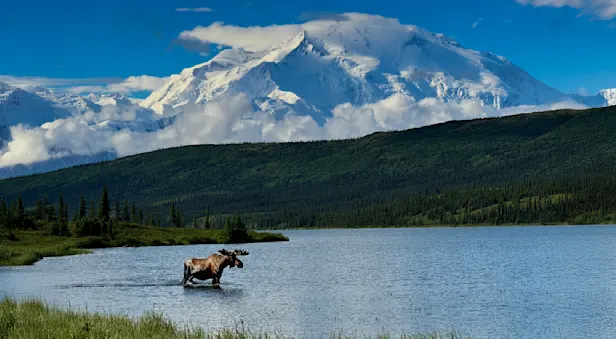
Ultimate Alaska Wildlife Safari
See more of wild Alaska on this wide-ranging, small-group adventure including Alaskan brown bears, a fly-in backcountry lodge in Denali National Park, marine life of Kenai Fjords, and the scenic Alaska Railroad to Seward.
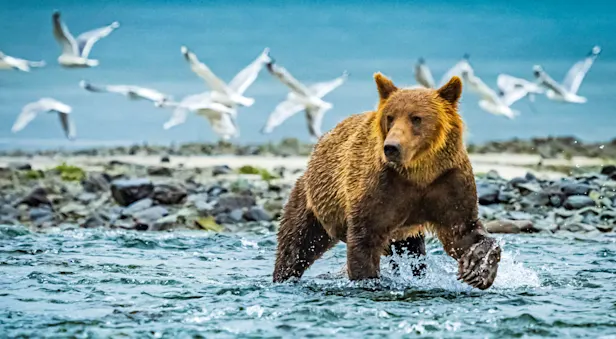
Nat Hab's Alaska Bear Camp
A secluded immersion with brown bears in the wilderness of Lake Clark National Park—enjoy total privacy and comfort at our deluxe fly-in wilderness camp accessed via chartered bush plane from Homer.
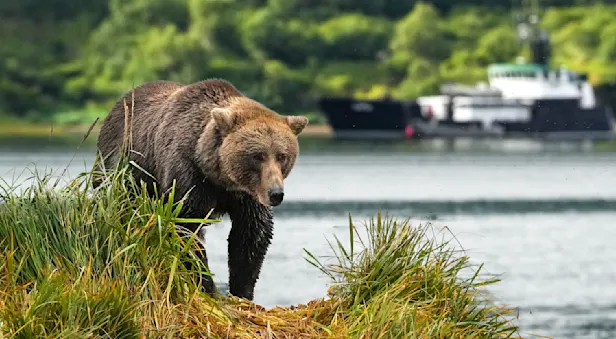
Alaska's Grizzly Ship: Kodiak to Katmai
An exclusive small-ship adventure to view giant brown bears—the world's largest "coastal grizzlies"—up close! Walk the shores as bears dig for clams, forage for sedges and pursue salmon in season in tidal streams.
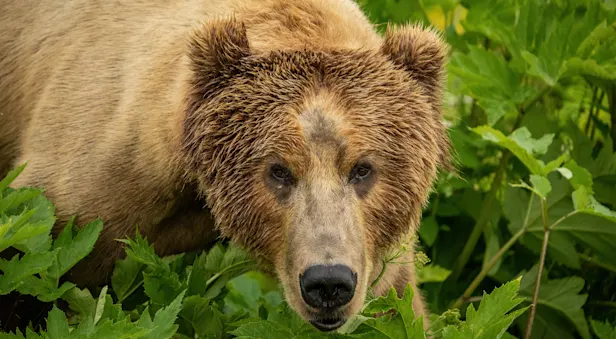
Ultimate Alaska Photo Expedition
A truly epic photography adventure! Alongside expert guides, get aerial shots of Denali from a helicopter; capture brown bear portraits at close range, and shoot glaciers, whales, puffins and more in Kenai Fjords.
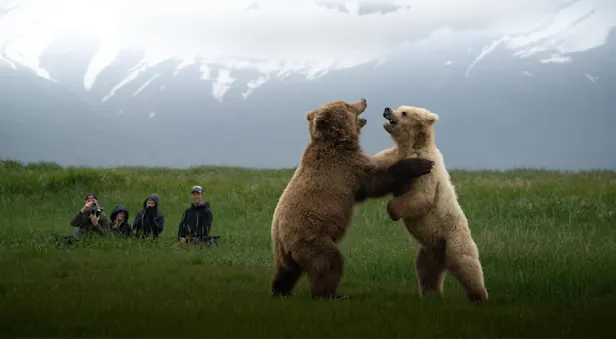
Grizzly Ship Photo Expedition: Kodiak to Katmai
Based aboard our private small ship, just eight guests photograph brown bears in the roadless Katmai wilderness, going ashore with an expert bear naturalist and photography pro who knows these animals intimately.
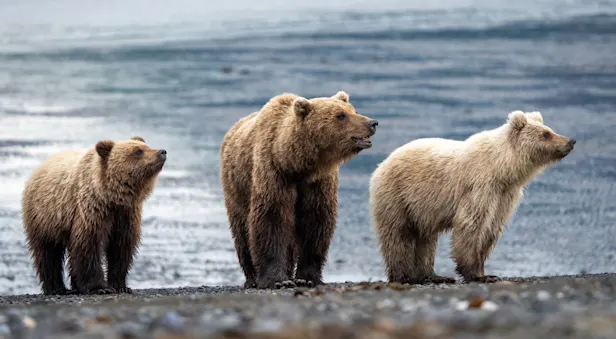
Alaska Bear Camp Photo Expedition
A secluded immersion with brown bears in the wilderness of Lake Clark National Park. Enjoy total privacy and comfort at our deluxe fly-in wilderness camp accessed via chartered bush plane from Homer.
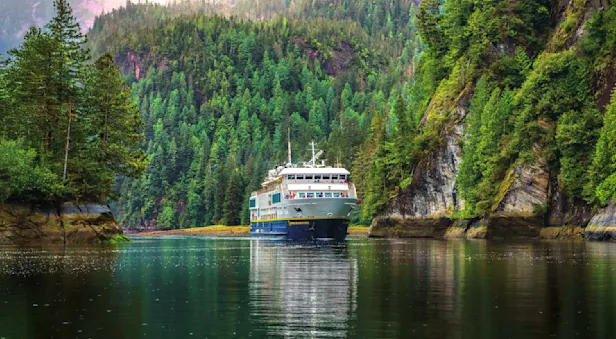
Alaska’s Inside Passage
A small-ship voyage through the narrow channels and fjords of Southeast Alaska's storied Inside Passage—meet wildlife up close in the company of top naturalists.
